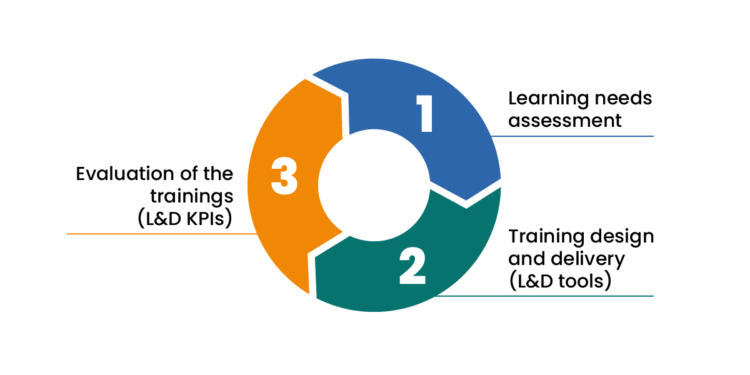Let’s start with the bigger picture. Organizations invest in infrastructure, technology, and new business opportunities. However, it’s shown that investing in staff might just be the thing that gives your organization the edge. That’s the area where the challenges of the Learning & Development department lie.
Learning and development strategy: shift in role and terminology
In recent years, learning and development have shifted some of its focus to catch up with the digital transformation and to join the digital learning journey, by building a learning ecosystem within the organization. This is not without its challenges. For example, implementing a new learning software tool could take up to a few years and how do you transfer old learning records or certificates?
Besides the shift toward digital learning tools, additionally, there’s another change. Training or learning does not have to serve a specific knowledge gap or business goal anymore. Within this, there’s a focus on employees’ talent to develop and grow without specifically advancing their career path within the organization. That’s why you’ll find organizations altered the name of the learning and development department to Talent and Organization Development or Talent Development to better describe the focus shift of the L&D role.
What is a learning and development course?
ATD defines learning and development as follows: “The term, learning and development, encompasses any professional development a business provides to its employees. It is considered to be a core area of human resources management, and may sometimes be referred to as training and development, learning and performance, or talent development (TD).”
The range of courses for L&D is very diverse. Among other things, the courses can differ in:
- Length: The length of a training course can vary greatly. Think of short microlearning modules to multi-day training or complete courses.
- Location: Do the trainings take place online or offline? There can also be a mix. This is called blended learning.
- Content: Sometimes a generic training can be chosen. Often, however, organizations will also look for ways to offer training that is developed specifically for an organization.
In short, learning and development courses can come in all shapes and sizes. It is always important that the chosen format meets the learning needs. More on that later!
Why is learning and development important?
Learning and development fulfills 3 big tasks:
- Learning needs assessment
- Training design and delivery
- The evaluation of those trainings
The evaluation in turn helps with the assessment of learning needs. This is the L&D circle.

Task 1: Learning needs assessment
Learning and development identifies needs at various levels:
- At the level of the organizational needs or culture,
- at the level of roles & positions,
- at the level of tasks and proficiency
- and lastly at the level of the individual employee.
This means that an L&D team uses a “demand-led” strategy. The focus of the demand has shifted slightly towards the roles, tasks and individual needs and using the organizational needs as guidance.
Task 2: Training design and delivery (learning and development tools)
When the analysis is done, it’s time for L&D to organize interventions, such as lectures, simulations, case studies, on-the-job training, coaching, mentoring, and e-learning. These interventions should be as effective as possible, that’s why the window between “learning” and the “application” is ideally as short as possible. e-Learning in the form of microlearning can prove to be particularly useful for these situations.
When developing education and training, organizations often look for the right tools. Is your organization looking for an L&D tool that allows you to register users and track results? Then an LMS is suitable. Do you want freedom in developing new training courses? Then look for a user-friendly authoring tool.
Task 3: Evaluation of the trainings (learning and development KPIs)
There are several learning and development KPIs you can choose to measure the success of your learning program. Think of employee feedback, hours spent on a training or the number of people who completed the training. But don’t only focus on these numbers. Also taken into account satisfaction and engagement.
When the learning and development department needs to assess if the learning intervention had the resulted effect. Ideally, you can compare two groups of employees: those who followed the training and those who didn’t. Then you collect feedback from the 1st group to ask for their responses, check their knowledge or skills, assess their behavior, and compare results. When you are comparing the results, take into account other circumstances like economic trends or geopolitical changes.
Now we’ve come full circle, the business results of the training and the feedback of the employees will impact the new learning needs. This requires new analysis and adequate development interventions.
How learning and development can benefit employees and organizations
Learning and development increases employee wellbeing and job satisfaction. Especially when the demand-led strategy comes from bottom-up, when the employees know that their requests are being heard.
The organization benefits from better-educated employees with improved skills and competencies. Last but not least, employees will be more motivated since their autonomy is respected.
The role of e-learning within learning and development
With e-Learning learning & development becomes more efficient because you can train a large group with 1 program, at the same time. It also ensures consistency, since your participants are all learning from the same course. No information will be forgotten or interpreted differently by the trainer.
With e-Learning, people can learn where and when they want. That’s why e-Learning emphasizes self-directed learning. This means that a lot of responsibility lies with the participant of the course.
Boost your learning and development strategy with FLOWSPARKS
Do you want to know how you can boost your learning and development strategy with the FLOWSPARKS platform? Schedule a demo with FLOWSPARKS. We’ll be happy to show you the possibilities.

